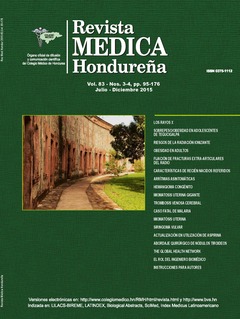Clinical and Epidemiological Features of Referred Newborns, Hospital Regional Santa Teresa, Comayagua, 2014-2015
Keywords:
Infant, Newborn, Klebsiella pneumonia, Referral and consultation, Shock, septicAbstract
Background: The Hospital Regional Santa Teresa (HRST), a second level hospital, is limited in its capacity to treat severe newborn cases by its infrastructure, equipment and staff. Objective: To describe the clinical and epidemiological characteristics of newborns referred from HRST, Comayagua, November 2014-April 2015. Methodology: Cross-sectional descriptive study. From 1,122 hospitalized cases, 142 (12.6%) newborns were referred; we reviewed 97 (68.3%) clinical records. Maternal and neonatal clinical and epidemiological data, laboratory results and diagnosis were registered. A database was created, EpiInfo version 7.1.5 (CDC, Atlanta). The results are presented as frequency, percentage and average. Personal information from cases was handled confidentially. Results: From 97 neonates, 66.0% (64) male and 84.5% (82) <24 hours of birth, 87.6% (85) was a child from a woman in age group 16-34 years old and 57.7% (56) with >4 prenatal visits. The 72.2% (70) presented sepsis manifestations, from these blood culture was performed in 39.2% (38) being Klebsiella pneumoniae the microorganism most frequently isolated 22.7% (22). The most frequent causes of referral included respiratory failure secondary to septic shock 20.6% (20), hyperbilrrubinaemia requiring exchange transfusion 11.3% (11) and necrotizing enterocolitis 7.2% (7). Discussion: In the period of 6 months, HRST referred 12.6% of hospitalized neonates, percentage 2.5 times higher than the standard for a second-level subtype I hospital (5.0%). It is necessary to strengthen the institutional capacity to treat neonates, especially operational aspects, to satisfy an increasing demand from Honduras central zone population.
Downloads
193




